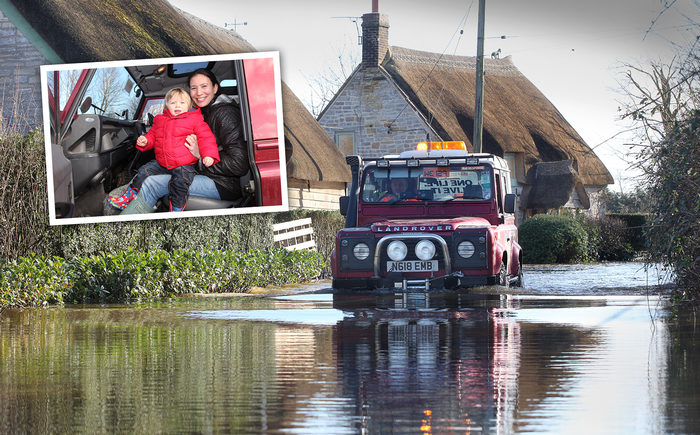How those affected by UK floods are being rescued by 4x4-driving heroes
Noah saved 2x2. Today’s rescuers do it 4x4
West Country villagers cut off by floods are having their lives made a little easier by teams of volunteer drivers who ferry them about in off-road vehicles. Alistair Weaver takes a ride
KATE MERRY and her young son Elliot are trying to cross the great divide. She lives in Muchelney, Somerset, near the River Parrett, which has risen to become an inland sea, turning the village into an island. “Water has come into our house on three separate occasions,” she says. “We’ve had to move into a holiday cottage across the road. Every day I have to get across the water so I can get on with my life.”
At first the family was reliant on local farmers for help. Then the farmers faced their own problems — rescuing livestock and farm machinery from the advancing waters. In their place, a band of dedicated volunteers descended, to move stranded families, help GPs reach their patients, deliver meals and medicines to the elderly and housebound and ferry supplies through water the colour of oxtail soup. Calling themselves 4×4 responders, some have been in the armed forces and have brought military-style organisation to a relief operation that now extends from Devon to Surrey.
4×4 Response was established in Norfolk in 1999 but the idea has spread nationwide and now there are more than 1,500 volunteers, organised into regional groups. Everyone who joins is assessed and receives at least half a day’s training.
All are equipped with their own off-roaders, which as well as providing transport and towing, power lights and radios and serve as makeshift sleeping quarters.
Today it is Simon Buckley at the wheel of his Land Rover Defender who is ferrying Merry and her son across the water. Now retired, Buckley has been drafted in from a nearby branch of 4×4 Response in Gloucestershire, and has helped about 50 people across the floods, including people going to work and schoolchildren. “I get the feeling the drivers are almost at breaking point,” he says. “They have been doing this for weeks and the strain is showing. I got the call yesterday and set off with my sleeping bag to help out.”
The responders get a mileage allowance from the local council but otherwise they pay their own way or rely on donations. “I bought the Defender to help tow my daughter’s horse box, so I think I may as well use it to help other people too,” says Buckley. He says he expects the Severn Valley to be next in need of help: “We’ve already had a warning text message go around: ‘Stand by — and get your wellies ready.’”
Graham Peet can normally be found fixing amphibious vehicles for the Ministry of Defence. Today, he is one of the volunteers working for the Wessex 4×4 Response Association. Their motto: to go where others fear to tread. For the past few weeks Peet and his team have been working in the area around Muchelney.
He pokes a stick through the window of his Suzuki Vitara and plunges it down into the water below. “It’s marked at 10cm intervals,” he explains. “It’s not exactly hi-tech but it’s how we measure the depth of the water.”
Today the water is 80cm (2½ft) deep, but that’s when you’re static. “You have to make allowances for the waves,” says Peet. “There’s so much water that if the wind gets up, you end up with waves washing against the vehicle. They can make the difference between getting through and getting stuck. You don’t want to add to the problem.”
This is Peet’s third trip along the “road” today. Last time he returned with the footwells of his car full of water after it seeped through his door seals. “People used to think of the Vitara as a bit of a hairdresser’s car,” he says. “I bought it so I could have some fun with my son, but it’s certainly earned my respect.” To date he has escorted an oil tanker through the floods to provide the locals with a much-needed supply of fuel, and helped a district nurse reach her patients. “Saturday night wasn’t quite so good, though,” he says. “I was delivering portable loos.”
“We attract all sorts of people,” says Jerry Greenhalgh, another responder, who worked as an electrical engineer before he retired. “We have doctors, solicitors, pilots, housewives — everyone has something different to offer.”
The mix of 4x4s is as eclectic as the volunteers. “Around 50% of our members drive Land Rover Defenders,” Greenhalgh says, “but I have a Jeep and there are lots of Toyotas and Mitsubishis. Our chairman uses his new Range Rover, but a lot of it depends on what sort of work you’re doing. You wouldn’t want to use an £80,000 vehicle for wading through dirty flood water day after day.” Like Buckley, Greenhalgh is part of the Gloucestershire and Worcestershire 4×4 Response team and has travelled two hours to come and help.
It’s far removed from the popular image of the modern 4×4 as a Chelsea tractor used for shopping trips to Selfridges. The Wessex group has based itself at a caravan site in the village of Thorney, just up the road from Muchelney. It hasn’t been turned into an island like its neighbour, but the road through the centre of the village is still impassable if you don’t have a boat or a 4×4. There’s a telephone number for locals to call if they need a lift.
Right on cue, the phone rings and we’re off on another mercy mission, this time to transport Luc Dominique-Smith, a local carpenter, to carry out essential repairs.
“It’s been almost impossible to work,” he tells me. “I can’t get the materials I need in and out. I even tried to use my kayak but then I couldn’t get it across the dry patches. Last year when we had some flooding, everything dried out in a couple of weeks. This year they reckon it might last until May.”
We crawl as slowly as we dare through the heart of the village. The traditional wading technique is to build up a bow wave in front of the vehicle, which reduces the amount of water getting into the mechanicals. But if you adopt that technique in a village, you risk pushing water through someone’s front door. “It’s a difficult compromise,” admits Greenhalgh. We stick to the centre of the road, passing little thatched cottages that bear the tell-tale stains of water damage. Sofas, damaged beyond repair, have been tossed into the front garden.
Driving Dominique-Smith is Tim Douglas in his Defender. “Normally most of the work we do is in the snow,” he explains. “We’re called in when the average Joe can’t get through in his car. Typically it’ll involve taking midwives to the hospital or patients back home. We’re really about being the first responders and giving the authorities time to react.”
Everyone is transfixed by the weather forecast, which is promising more and more rain. No one is sure when anything will return to normal. For now, all this plucky band of brothers can do is to keep checking the levels and wading on through.
Driving in floods – advice
- Watch your ground clearance and avoid driving through anything deeper. Once water reaches your car’s floor, the vehicle will start to become buoyant and float. According to the Environment Agency, just 12in of flowing water can be enough to move a family car. Double it to 2ft and that same vehicle will simply float away.
- Keep the engine revs high so as not to stall and to help prevent water entering the exhaust pipe. To keep speed down, ride the clutch, or in an automatic select the lowest gear position. In a 4×4, make sure you are in four-wheel drive.
- If you feel the car start to float, because the water is deeper than you thought, you are driving too quickly or you get swamped by another car, select neutral immediately, and keep the engine revving. Hopefully the car will settle back onto the road, and you can carry on or reverse out.
- Once through the flood, touch your brakes momentarily to clear water from them — and be prepared for the car in front of you to do the same.





